San Cristobal de la Habana El Principe

After three years of relentless exposure via my co-host Craig, an international move, and the newly legalized ability to buy Cuban cigars outside the U.S., I have recently begun a foray into the available offerings. I’m neither well-versed nor experienced in this arena, but I suppose writing a cigar review is writing a cigar review. I don’t think I will reach a point of complete conversion from my normal Dominican and Nicaraguan standards, but have largely enjoyed those Cuban marcas I have tried. Today, I’m covering the San Cristobal de la Habana El Principe, a tiny little cigar that’s readily available and affordable in Santiago. Vitola details are listed at right in the sidebar.
Pre Light
The El Principe is a fairly even, moderate brown color throughout with occasional slight mottling. The mottling typically presents around telegraphed wrapper bumps and handling marks. Veining in the wrapper leaf is modest. For all the examples I’ve smoked, the pack density has been acceptable to very good. Some have been slightly tighter than ideal but tolerable. The pre light draw provides hay like flavors with some sweetness. The aroma is almost nonexistent around the wrapper, with some leather at the foot.
The Smoke
Almost universally, the first few puffs have been airy with some floral notes. As with other San Cristobal vitolas I’ve tried, the El Principe quickly transitions to a more refined sweetness – caramel like, for lack of a better descriptor. By the beginning of the second third, the cigar really comes into its own to my tastes. The early sweetness subsides greatly, revealing a core set of flavors that are more in the spectrum of the “tropical spice” we so often speak of on Half Ashed. The flavors are bright, but not peppery. The spice I speak of is more akin to allspice than pepper. This will persist throughout the midsection.
Some of the El Principes I’ve smoked have had a tendency toward a wandering burn, occasionally severe. When it does occur, it’s usually in the final portion. During this final stretch, the flavors intensify, but can become sensitive to overpuffing (perhaps due to this particular vitola’s diminutive size). A woodsy core with slightly vegetal flavor is common.
Summary
Overall, I enjoy the San Cristobal de la Habana El Principe. It pairs amazingly well with café Dominicano. I think it is a very good cigar – and worthwhile around the $6.50US price point…if you’re a slow smoker. While there are a number of others I typically would reach for first, I’m not averse to keeping a few around They won’t change your life, but as an excursion into the Cuban market I’m glad to have stumbled onto them.
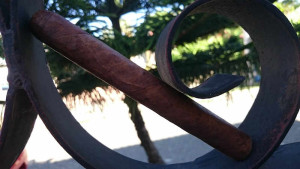 Since moving to the Dominican Republic, I have experienced a renewed interest in Dominican cigars, specifically brands to which I’d had no previous exposure while stateside. The impetus for this renewal has largely been Chogüí Cigars, with the Dos77 line. After enjoying the Dos77 and subsequently having the opportunity to spend some time with owner Victor Nicolás on the “Top Secret Nest” production floor learning about his brand, I was excited to try the upcoming Chogüí PrimerAño. This release is a celebration of Chogüí’s first year in business, and was rolled in November 2014 (the time of the company’s Dominican launch). Although the core Dos77 line has now grown to include some U.S. distribution, the PrimerAño is a limited run that will likely only be sold in the Dominican Republic. It was produced in a singular 5.5” x 46 vitola, using tobacco from both the original Primera Edición and the existing Dos77 blends. The wrapper on the PrimerAño is Dominican grown, Cuban-seed HVA (Habano Vuelta Arriba), the binder is Dominican Criollo ’98, and the filler blend consists of Dominican Criollo ’98 and Habano 2020. Pricing is still under review, but are expected to retail for approximately $9 U.S. Samples for today’s review were provided by Victor Nicolás.
Since moving to the Dominican Republic, I have experienced a renewed interest in Dominican cigars, specifically brands to which I’d had no previous exposure while stateside. The impetus for this renewal has largely been Chogüí Cigars, with the Dos77 line. After enjoying the Dos77 and subsequently having the opportunity to spend some time with owner Victor Nicolás on the “Top Secret Nest” production floor learning about his brand, I was excited to try the upcoming Chogüí PrimerAño. This release is a celebration of Chogüí’s first year in business, and was rolled in November 2014 (the time of the company’s Dominican launch). Although the core Dos77 line has now grown to include some U.S. distribution, the PrimerAño is a limited run that will likely only be sold in the Dominican Republic. It was produced in a singular 5.5” x 46 vitola, using tobacco from both the original Primera Edición and the existing Dos77 blends. The wrapper on the PrimerAño is Dominican grown, Cuban-seed HVA (Habano Vuelta Arriba), the binder is Dominican Criollo ’98, and the filler blend consists of Dominican Criollo ’98 and Habano 2020. Pricing is still under review, but are expected to retail for approximately $9 U.S. Samples for today’s review were provided by Victor Nicolás.
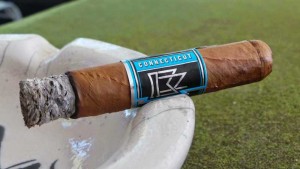 At first light, there’s a crisp, tannic note that brings a moderate tropical spice through the nose. While I’m not the biggest fan of Connecticut wrapper, from time to time I do enjoy the sharp flavor it brings. I also tend to really enjoy the room note of this leaf – which bears true with today’s stick. The burn was generally well behaved for this cigar, and I can’t really say that I had to do much in the way of maintenance. Just an occasional brush with the lighter kept it in check. Once I got into the second inch of the Nestor Miranda Connecticut, the profile had settled into a sweeter range. The tropical spice persisted, with a bit of cedar thrown in for good measure. By the time I approached the end of the cigar, it was losing most of its spicy character while the sweetness continued to build. This sweetness finished brilliantly, with a definite butterscotch bent to it. In what is one of the stranger flavor pairs, there was an occasional wisp of cinnamon as well during this final portion. A strong performance, with a tasty finish.
At first light, there’s a crisp, tannic note that brings a moderate tropical spice through the nose. While I’m not the biggest fan of Connecticut wrapper, from time to time I do enjoy the sharp flavor it brings. I also tend to really enjoy the room note of this leaf – which bears true with today’s stick. The burn was generally well behaved for this cigar, and I can’t really say that I had to do much in the way of maintenance. Just an occasional brush with the lighter kept it in check. Once I got into the second inch of the Nestor Miranda Connecticut, the profile had settled into a sweeter range. The tropical spice persisted, with a bit of cedar thrown in for good measure. By the time I approached the end of the cigar, it was losing most of its spicy character while the sweetness continued to build. This sweetness finished brilliantly, with a definite butterscotch bent to it. In what is one of the stranger flavor pairs, there was an occasional wisp of cinnamon as well during this final portion. A strong performance, with a tasty finish. The wrapper on the Nestor Miranda Habano is a bit dryer to the touch than the Connecticut, with some micro-tooth throughout. There’s almost no aroma from either foot or wrapper. The cigar is evenly packed with neither soft nor dense spots. Veins are moderate, and seams barely visible. Coloration is medium brown and evenly distributed. Like the Connecticut, the cold draw produces little flavor to speak of. The draw on this example is slightly tight.
The wrapper on the Nestor Miranda Habano is a bit dryer to the touch than the Connecticut, with some micro-tooth throughout. There’s almost no aroma from either foot or wrapper. The cigar is evenly packed with neither soft nor dense spots. Veins are moderate, and seams barely visible. Coloration is medium brown and evenly distributed. Like the Connecticut, the cold draw produces little flavor to speak of. The draw on this example is slightly tight.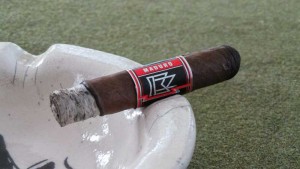 The Nestor Miranda Maduro, like its Habano brother, fires up with little spice at its outset. The early core flavors are bready with just a touch of a sweet, toasty character. I was a little surprised by this. Although I knew the blends were reportedly different in each of the three offerings, I felt like the Connecticut and Habano followed a common palette – or family – of flavors. The maduro seems more unique in this respect, providing a decidedly different experience. By the time I arrive at the second inch of the cigar, the smoke production has become strained. The cigar nearly went out a couple of times, but would revive with a quick puff. Flavors at this point remain similar to the early portion, but take a noticeably more astringent turn nearing the final third. This continued to build through to the end. The draw was tighter than I would usually prefer throughout this cigar, and I believe it may have slightly overheated due to my trying to overcome its tendency to resist staying alight.
The Nestor Miranda Maduro, like its Habano brother, fires up with little spice at its outset. The early core flavors are bready with just a touch of a sweet, toasty character. I was a little surprised by this. Although I knew the blends were reportedly different in each of the three offerings, I felt like the Connecticut and Habano followed a common palette – or family – of flavors. The maduro seems more unique in this respect, providing a decidedly different experience. By the time I arrive at the second inch of the cigar, the smoke production has become strained. The cigar nearly went out a couple of times, but would revive with a quick puff. Flavors at this point remain similar to the early portion, but take a noticeably more astringent turn nearing the final third. This continued to build through to the end. The draw was tighter than I would usually prefer throughout this cigar, and I believe it may have slightly overheated due to my trying to overcome its tendency to resist staying alight. Earlier this year, General Cigar released
Earlier this year, General Cigar released 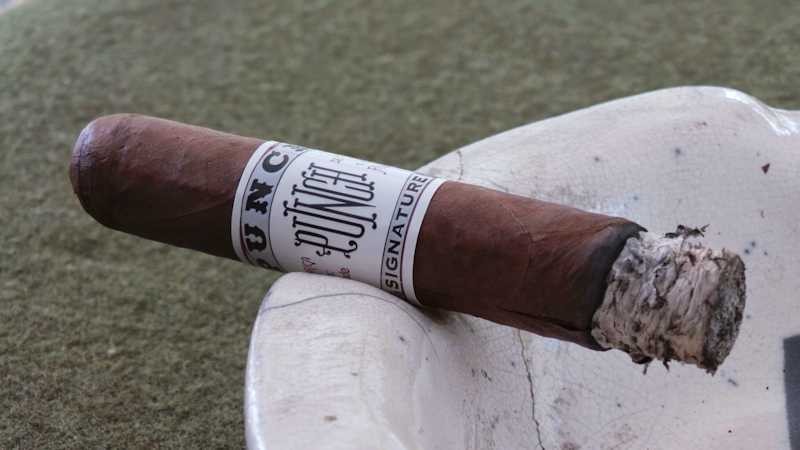 Going into the second third of the Punch Signature brings further development of the chile pepper flavor without a measurable change in the nasal spice on retrohale. As the chile takes a more prominent role, the earlier almond flavor subsides, which brings in more sweetness. This provides a very entertaining chili-chocolate combination that brings
Going into the second third of the Punch Signature brings further development of the chile pepper flavor without a measurable change in the nasal spice on retrohale. As the chile takes a more prominent role, the earlier almond flavor subsides, which brings in more sweetness. This provides a very entertaining chili-chocolate combination that brings  Going into the second inch, the Dark Rituals really begins to mature, showing a depth of flavor that I had not expected. The sweet, leathery profile has intensified and settled into a comfortable pitch. There are erratic inclusions of a nebulous citrus flavor that are fleeting but very charming when they show. I did have some issue with the burn wanting to wander. This never grew to a point that was catastrophic to the experience, but regular touch ups were required throughout the length of both examples smoked for this review.
Going into the second inch, the Dark Rituals really begins to mature, showing a depth of flavor that I had not expected. The sweet, leathery profile has intensified and settled into a comfortable pitch. There are erratic inclusions of a nebulous citrus flavor that are fleeting but very charming when they show. I did have some issue with the burn wanting to wander. This never grew to a point that was catastrophic to the experience, but regular touch ups were required throughout the length of both examples smoked for this review. In July of 2014, we featured the Trinidad Ingenios Edición Limitada as our Cigar of the Week on
In July of 2014, we featured the Trinidad Ingenios Edición Limitada as our Cigar of the Week on  Unlike most reviews here on Half Ashed, I have not had two of this particular line in quick succession; they were spaced three-quarters of a year apart. Nonetheless, I wanted to know how the two would compare. I had a different-than-expected experience during the show, and wanted to see if the same would hold true today.
Unlike most reviews here on Half Ashed, I have not had two of this particular line in quick succession; they were spaced three-quarters of a year apart. Nonetheless, I wanted to know how the two would compare. I had a different-than-expected experience during the show, and wanted to see if the same would hold true today. The initial puffs from the Trinidad Ingenios are almost floral. It reminds me of the “Old Timers’” pipe tobacco blends with their hints of anisette. The floral character continued to sweeten, becoming almost like some sort of honeyed confectionery. This would endure throughout the first third and into the second, and is a radical difference from what I experienced when we smoked these in 2014.
The initial puffs from the Trinidad Ingenios are almost floral. It reminds me of the “Old Timers’” pipe tobacco blends with their hints of anisette. The floral character continued to sweeten, becoming almost like some sort of honeyed confectionery. This would endure throughout the first third and into the second, and is a radical difference from what I experienced when we smoked these in 2014.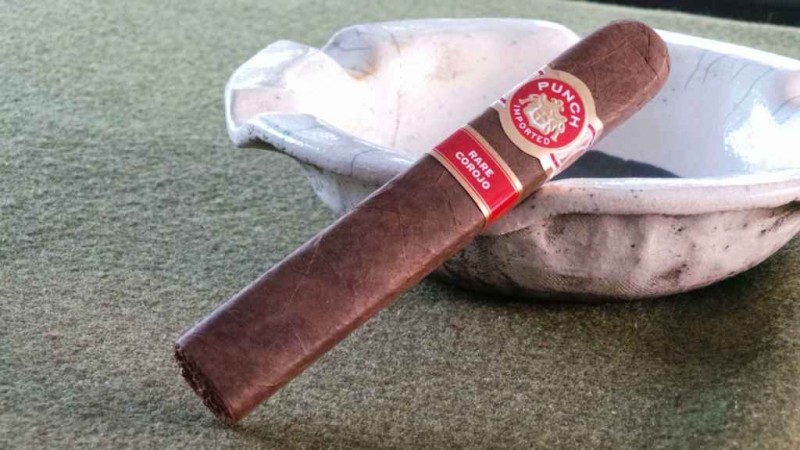 I recently received a couple samples of the seasonal Punch Rare Corojo release, which made its return in February. This year, the line sees two extensions – a permanent addition in the form of a 6.5” x 66 “El Diablo,” and a limited 6.75” x 56 tapered “Rare Lapiz.” Today we’re looking at the “El Diablo,” which retails for about $8.25 per cigar and will be packaged in the typical wooden cabinet box. The “Rare “Lapiz” will be available for a limited time and in special ten-count boxes.
I recently received a couple samples of the seasonal Punch Rare Corojo release, which made its return in February. This year, the line sees two extensions – a permanent addition in the form of a 6.5” x 66 “El Diablo,” and a limited 6.75” x 56 tapered “Rare Lapiz.” Today we’re looking at the “El Diablo,” which retails for about $8.25 per cigar and will be packaged in the typical wooden cabinet box. The “Rare “Lapiz” will be available for a limited time and in special ten-count boxes.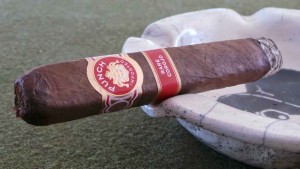 The initial puffs from this year’s Punch Rare Corojo are colored by a nice, sweetened-coffee flavor. The draw is near perfect, although smoke production is inconsistent during the early minutes. This Café Cubano flavor tendency would continue throughout the first third of each cigar. By the second third, a clean, almost minty flavor has peeked through a few times, but is still accompanied by the coffee. There is a bit of spice on the retrohale. The ash is generally well behaved, but prone to flaking and did fall prematurely a couple of times over the two samples smoked. The strength built during the midsection, but universally remained well within the medium range for my tastes. As the cigar progressed toward its final portion, the profile became more leathery, while continuing with the sweetness. The finish carries this sweetness as well, which was a nice surprise. Only during the final moments of the marathon 2.5 hour smoke session did the El Diablo give even a hint of being “done.” Some (very slight) burnt notes were the only indicator that it was time to put the cigar down.
The initial puffs from this year’s Punch Rare Corojo are colored by a nice, sweetened-coffee flavor. The draw is near perfect, although smoke production is inconsistent during the early minutes. This Café Cubano flavor tendency would continue throughout the first third of each cigar. By the second third, a clean, almost minty flavor has peeked through a few times, but is still accompanied by the coffee. There is a bit of spice on the retrohale. The ash is generally well behaved, but prone to flaking and did fall prematurely a couple of times over the two samples smoked. The strength built during the midsection, but universally remained well within the medium range for my tastes. As the cigar progressed toward its final portion, the profile became more leathery, while continuing with the sweetness. The finish carries this sweetness as well, which was a nice surprise. Only during the final moments of the marathon 2.5 hour smoke session did the El Diablo give even a hint of being “done.” Some (very slight) burnt notes were the only indicator that it was time to put the cigar down.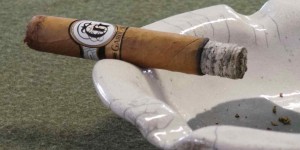
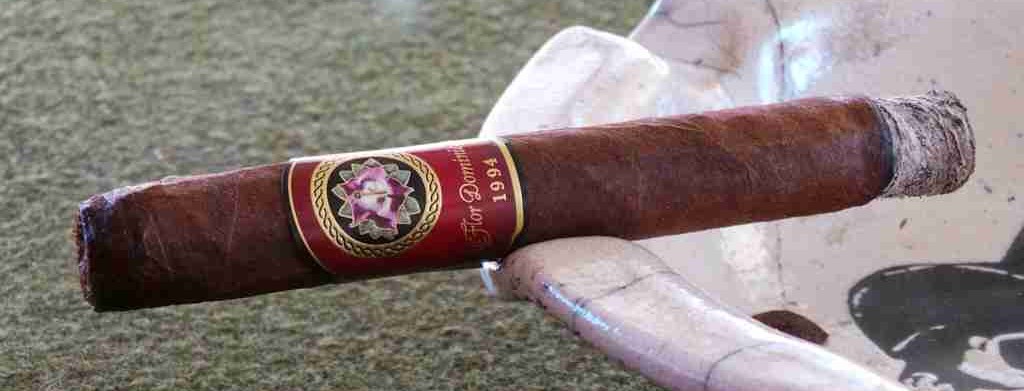 Today’s review is for the La Flor Dominicana 1994 “Rumba.” The cigar was introduced at IPCPR 2014, in celebration of the Gomez family’s 20 years in the cigar industry. The 1994 has a Mexican San Andres wrapper over Dominican binder and fillers. As detailed in a
Today’s review is for the La Flor Dominicana 1994 “Rumba.” The cigar was introduced at IPCPR 2014, in celebration of the Gomez family’s 20 years in the cigar industry. The 1994 has a Mexican San Andres wrapper over Dominican binder and fillers. As detailed in a 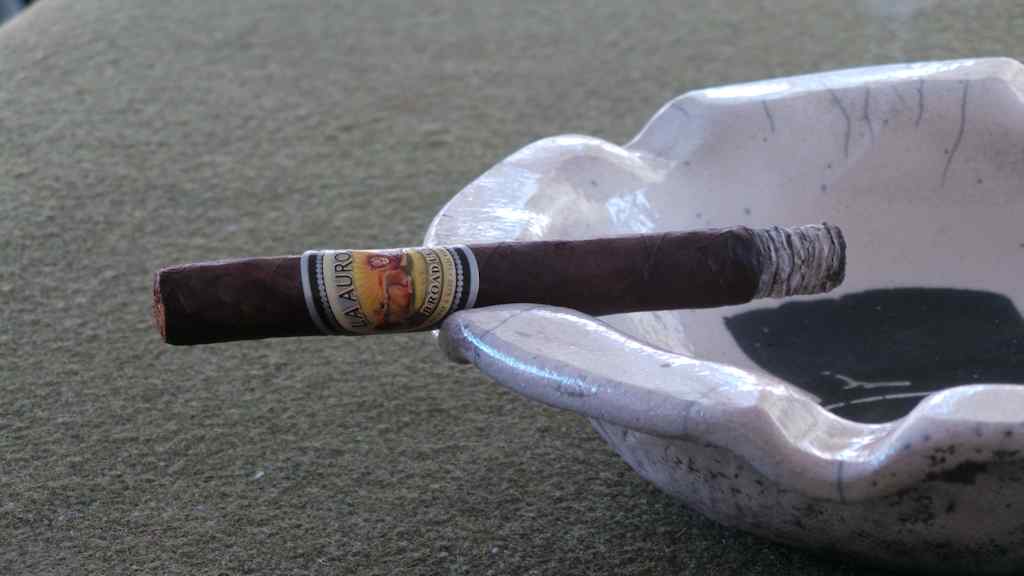 I recently received a package of cigars from Miami Cigar. Inside were 6 different varieties of a Mid-Atlantic regional exclusive release for a new vitola in the Preferidos lineup. The offering will include the original Preferidos blend, draped in each of the six wrappers (Brazilian sungrown (Ruby), Cameroon (Platinum), Connecticut (Sapphire), Connecticut broadleaf (Diamond), Corojo (Gold) and Ecuadorian Sumatra (Emerald)) – but in a 5.5” x 42 Corona Especiales vitola. They will be sold exclusively in the Mid-Atlantic region, and retail for about $7.20 per stick. The line will also be available in a 150-count crate containing 25 each of the wrapper varieties.
I recently received a package of cigars from Miami Cigar. Inside were 6 different varieties of a Mid-Atlantic regional exclusive release for a new vitola in the Preferidos lineup. The offering will include the original Preferidos blend, draped in each of the six wrappers (Brazilian sungrown (Ruby), Cameroon (Platinum), Connecticut (Sapphire), Connecticut broadleaf (Diamond), Corojo (Gold) and Ecuadorian Sumatra (Emerald)) – but in a 5.5” x 42 Corona Especiales vitola. They will be sold exclusively in the Mid-Atlantic region, and retail for about $7.20 per stick. The line will also be available in a 150-count crate containing 25 each of the wrapper varieties.